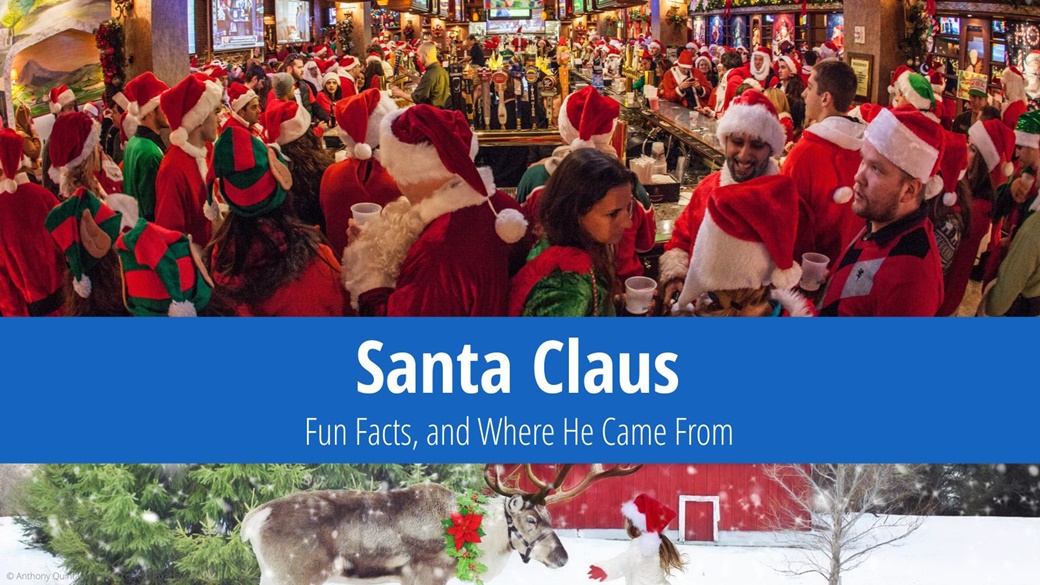The origin of Santa Claus can be traced back to the Netherlands, where he was called Sinterklaas and resembled a bishop in his attire. In the USA, the character began to appear after 1624, when New Netherland was established in the area of what is now New York. When did he get his American name and who popularized the world-famous character?

-
Table of Contents
Where Did Santa Claus Come From
The figure of Santa Claus originates from the Greek bishop St. Nicholas, whose veneration later spread to the Netherlands. According to historically documented information, Sinterklaas was depicted wearing a red cloak and mitre, and may have resembled a bishop in appearance.
The figure of Sinterklaas was brought to American territory by the Dutch during the 17th century after New Netherland was established on the East Coast. Who first used the name “Santa Claus” is not entirely clear. The transformation of Sinterklaas into Santa Claus was a gradual process, with writers and illustrators playing a major role.
The figure of Saint Nicholas, based on Dutch traditions, was greatly popularised by the writer Washington Irving in his satirical book A History of New York in 1809. The name ‘Santa Claus’ does not appear in the book, but it had already been circulated by word of mouth and in printed publications.
The poem A Visit from St. Nicholas (better known as The Night Before Christmas), written by Clement Clarke Moore and first published in the Sentinel newspaper in 1823, solidified the image of Santa Claus in American culture. The poem connects the kindly nature of Santa Claus with his reindeer and the tradition of delivering gifts during nighttime visits.
The illustrator Thomas Nast is credited with the physical appearance of Santa Claus. Sometime after 1863, Santa Claus began appearing in Harper’s Weekly magazine as a stocky, good-hearted man with a white beard who was dressed in a red coat with fur.
The illustrator and advertising designer Haddon Sundblom also played a significant role in popularizing Santa Claus. From the 1930s onwards, his illustrations of a jolly Santa Claus in a red costume began to be used by the Coca Cola company in its advertisements.
One of the popular myths is that Coca Cola invented Santa Claus. As noted above, this is not true. However, Coca Cola did help spread awareness of the guy in the red suit, making him a globally known symbol of Christmas.
-
What Are the Names of Santa Claus’ Reindeer?
The names of Santa Claus’ reindeer are Dasher, Dancer, Prancer, Vixen, Comet, Cupid, Dunder (later modified to Donner), and Blixem (later modified to Blitzen).
Santa Claus’ reindeer first appeared in the aforementioned poem, “A Visit from St. Nicholas”, by author Clement Clarke Moore. The poem was first published in the American newspaper Troy Sentinel on December 23, 1823. In the poem, the reindeer already pull the sleigh of St. Nicholas, who later evolved into Santa Claus.
The reindeers’ original names, Dunder and Blixem, are based on the Dutch words for thunder (donder) and lightning (bliksem). In later editions of the poem, the names were changed to the English-sounding Donner and Blitzen.
The ninth reindeer, Rudolph the Red-Nosed Reindeer, did not join the group until 1939, when he appeared in a promotional book for the Montgomery Ward department store. According to the story, Rudolph joined the pack during one Christmas when a snowstorm was raging and the original eight reindeer were not strong enough to pull Santa Claus’ sleigh.
-
Fun Facts About Santa Claus
🎅 How Many People Impersonate Santa Claus for a Living
The exact number will probably never be known, but it is estimated that around 8,000 people in the USA play Santa Claus for a living. Santa Clauses in red suits talk to children in department stores, take pictures with them, and find out their Christmas wishes.
Before Christmas, some Santa Claus impersonators attend workshops on appropriate behavior and receive advice on how to keep in good spirits.
🎅 When Santa Claus Was Born
The precursor to Santa Claus is Saint Nicholas, who was born around 270 AD in Patara, Lycia, and later served as bishop in the Greek city of Myra (now in Turkey). This year is usually given as the date of Santa Claus’ birth. According to legend, Santa Claus is kept alive and in great shape by the magic of Christmas.
🎅 The U.S. Army Tracks the Location of Santa Claus
In 1955, Sears printed an ad with the phone number of a toy store where children could call to make their Christmas wishes. A typo crept into the ad, and the children accidentally called the commander of the U.S. Air Defense Forces. This accidentally created a lovely Christmas tradition in which the military tracks Santa Claus’s current location.
🎅 Coca Cola Christmas Ads With Santa Claus
Santa Claus’s appearance was largely shaped by Coca-Cola advertisements, which were created from 1931 under the hands of illustrator Haddon Sundblom. The painted posters featured a jolly bearded man in a red and white suit. For decades, these illustrations were a traditional part of Coca Cola’s Christmas campaign.
In the mid-1990s, Coca Cola’s Christmas TV campaign featuring Santa Claus was complemented by brightly lit Coca Cola trucks set against winter landscapes. Santa Claus first appeared in a Coca Cola TV commercial in the 1950s, when he prepared Christmas presents in his workshop with the help of elves. Coca-Cola was promoted as a refreshing drink.
🎅 What Is the Name of Santa Claus’ Wife
According to tradition, the wife of Santa Claus is referred to simply as Mrs. Claus. In literature, Mrs. Claus began to appear much later than her husband, and so is not as prominent a part of Christmas traditions. In some films and books, her name is mentioned, but it varies throughout.
🎅 Where Santa Claus Lives
According to tradition, Santa Claus and his elves live at the North Pole year-round. In Canada, Santa Claus has even had his own postal code, H0H 0H0, since 1983. Canadian postmen even answer children’s Christmas letters.
🎅 How Fast Santa’s Sleigh Flies
Santa’s sleigh is said to fly at the speed of light, reportedly covering a distance of up to 1.08 billion kilometres in an hour. During Christmas in the US alone, Santa Claus has to deliver presents to 90 million households in one night. If his work shift lasts 12 hours, he must visit 2 083 households every second.
🎅 What Santa Claus’ Laugh Sounds Like
The traditional Santa Claus laugh sounds like “Ho, ho, ho!“. The concept of this laughter became widespread during the 20th century, as illustrations and stories about Santa Claus began to appear in films, radio plays, and later television commercials.
🎅 How Children Reward Santa Claus
American children usually leave cookies for Santa Claus on the fireplace as a thank you, complete with milk and carrots for the reindeer. In Ireland, according to advertising tradition, Santa Claus is offered Guinness beer and in Norway and Sweden, rice porridge serves as a reward.
🎅 The Best Christmas Movies With Santa
Santa Claus is featured in almost all American Christmas movies. Some of the most famous ones include Miracle on 34th Street (1947), The Santa Clause (1994), Bad Santa (2003), Fred Claus (2007) and The Nightmare Before Christmas (1993).
🎅 Who Brings Presents in Other Countries of the World
In France and the francophone region of Canada, Père Noël brings presents to children. In Spain and Mexico, it is the Three Kings (Los Reyes Magos), in Germany, it is either Christkind or Weihnachtsmann, depending on the region. In Italy, Babbo Natale brings presents at Christmas, in Poland, it is Święty Mikołaj; in Estonia, it is Jõuluvana; and in Japan, it has traditionally been Hotei-Osho.
🎅 How Santa Claus Differs in Different Countries
In Canada, Santa Claus blends with the French Père Noël. The result is a similar emphasis on commerce, often complemented by elements of family and nature. In Europe, Santa Claus is primarily known through the media, but local traditions have a stronger presence, with figures such as Santa Claus, Christkind, or Jultomten.
In Asia, Santa Claus primarily appears in shopping malls and advertisements and is not usually associated with deeper traditions. In Australia and New Zealand, Santa Claus adapts to the summer environment, often appearing on beaches or wearing shorts.

 10 Best Photo Places in the USA
10 Best Photo Places in the USA




Contribute with Your Question or Personal Experience